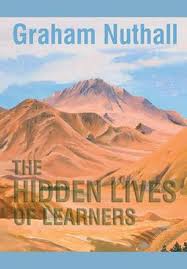Or The Hidden Lives of Learners
My subtitle alludes to the extraordinary book by Graham Nuthall that brought together his life’s work in educational research.

It is a liberating book for teachers who intuitively understand that live lessons contain layers of strata and substrata.
- There is a visible dimension in teaching that they can plan for and observe, like tasks and products.
- There are several layers of semi-visible indicators that may or may not show that students are learning, that can be social, oral, behavioural.
- Then there is the invisible layer of each student’s individual mental activity.
By talking with students as they learn, about the products of their learning and that of others we can gain insights into this invisible mental life, but we should never kid ourselves that we either see it clearly or are in control of it.
Teaching Let’s Think is no different and neither is teaching Let’s Think in Lockdown.
After session 1, I reflected on some of the signs that individuals had connected with the session and were developing their understanding through it. I also had to admit that some contributors were more confident and dominant than others. There were visible signs of mental ‘drift’ which, as we know from the child staring out of the window in the classroom, can tell you everything or nothing about whether they are developing understanding.
To build social trust, connections and reflections on each session, I had prompted everyone to add thoughts to the family WhatsApp group we have – which we call ‘The Village’.
If there was someone who helped you think differently or more deeply, post it on The Village. Our family modelled this for the group to lead the way.
‘We nominate X for her contributions on feminism, civil war and the importance of geography. We thank you.’
‘OMG, I’m thrilled! I am bursting with ideas after our session. Thankyou for the opportunity to THINK!’
Heartening ‘visible’ feedback. But no further comment ensued…
Back to the sessions…
Same story – different openings
In The Bridge 2, we are invited to consider 5 different ways that writers might choose to render an engaging narrative from the basic plot of The Bridge. The main focus shifts from frames of reference to the effect of narrative sequencing. ‘If the story starts with a focus on this character in this way we will feel X whereas if we start in this way we feel Y or if we start at a different point in the plot, we will feel Z.’ In the application or ‘bridging’ task, we invite learners to write their own opening to The Bridge – providing a different source of insight in to their mental life. Could I ask my family to do writing for homework?….I mean, this was primarily a way to socially connect and keep our minds agile.
There is an increase in reading demand compared to lesson 1. I farmed out the responsibility to read the first 3 openings (around 700 words in total) to each family group and asked them to decide before the live session which they feel would make the best opening.
Since the initial passages are quite long – forgive me for summarising their tone and tenor:
Passage A offers a description of the town, Brownsville (inference anyone?) that sprang up as a crossing over the Wilson River, initially relying on boats to shuttle goods and inhabitants. That is, before the building of the bridge. In the advent of the bridge, Todd Swift, the boatman, had gradually seen his livelihood fall away and his bitterness increase.
Passage B is somewhat Mills and Boon. The woman becomes ‘Mary’ who is lively, attractive and rather trapped in a solid but dull town and a solid but dull marriage. She has caught the eye of a local farm-hand, Eli, who ‘does not attend church,’ and lounges against its outside wall.
In Passage C we are in a dark version of Little House on the Prairie. Amos, the husband, is leaving Ruthie his ‘once pretty’ wife to manage a cluster of children, while he travels for business to Washington. We infer that the marriage is loveless, with an intimation of emotional abuse ‘He expected her to come when he called’ and perhaps physical when we hear that the little girl, Maisie, ‘flinched and hid behind her mother’ when her father reaches for her.
Which would make the best opening?
Since I had not been party to the concrete preparation for the lesson, I did a quick check in. Todd in passage A is the boatman and the bridge that has ruined his livelihood is the one that woman crosses. The woman becomes Mary in passage B, her husband is John, and it looks like Eli will become her lover. And so on. If we do not establish this we cannot begin to evaluate how our responses to the same character can differ in their different stylistic manifestations. Social construction unravels without shared terms of reference.
So, family #1, which do you think would make the best opening?
Well – we think they could all work
Let’s pause and think for a moment what the ‘hidden life’ behind this response could be. At times, this kind of response can be a way to dismiss the value of the task. ‘They can all work’ can be a kind of multiplist ‘well, whatever’ response. But I did not ‘hear’ that was what this family meant. I chose to hear that they had considered each option carefully and had seen merits in them all. I can stay in the multiplist zone (there are options and they are all valid) and probe the relative merits of each one. Alternatively, I can force some conflict. If we had to choose one, which would we choose and why? This at once forces the group to make their criteria for judgement available to others and it creates an evaluative frame for the session moving forward. Even though we had only recently come together as a group – I gave some breakout time – insisting that each family propose just one opening.
There was a remarkable degree of agreement across the 4 family groups. Unlike in many KS3 classrooms, this ‘collective consciousness’ argued for Passage A. They came to realise that they liked the cinematic wide angle shot of the town of Brownsville, the mid-shot to focus on the bridge then the close-up on Todd the boatman and his inner bitterness.
I kept prompting them to use the criteria in their argument that they had agreed on in the first session about engaging narratives to test out the value of Passage A –
After what X said about the town and its position on the river and in the Civil War – we thought that some social and geographical context was important to us
Family Y’s comments on the boatman have really stayed with us and we said we want characters who have shades of grey – we are fascinated by them but they are flawed.
He’s also going to get to know all the secrets of the town – look it says that he would transport them at any time day or night if they don’t want to be seen crossing.
We can get to know all the other characters’ dirty secrets through him!
Passage B was going to be enjoyable. At one point, it seemed like the group was going to talk themselves into this being their favourite. We would like Mary and we are effortlessly drawn into her easy character. The Mills and Boon seduction was doing its magic. Then came a brave voice of dissent.
In Passage B we are being told what to think about the characters. Mary is ‘warm’ and ‘friendly’ and ‘pretty’. In C we can build our own views of the characters through the details we are given.
Is that important to you as a reader?
Yes, because you have to bring much more to the text and so the characters have depth and life
Do we all think that’s important – to be shown and not told what to think?
(general nodding)
Passage C is the best writing, but we know the experience of reading it is going to be pretty grim.
Yeah, yeah – I’m not sure I want to inflict the pain of reading that one on myself (laughter…)
Personal responses were still being shared and valued but within an evaluative frame in which we constantly seek further opinions and possibilities if they are evidenced.
Cognitive conflict
Now we reached the hinge point in the session that Let’s Think teachers will know as the cognitive conflict. I asked families to mute their microphones, take some time out to read passage D and E and discuss whether they could work as an opening. The passages are included followed by a taster of the ensuing discussion.
Passage D
Amos Turley stood by his wife’s grave. It was just a mound of earth and stones the length and width of her body, and a plain wooden cross with her name and dates. He clenched his fists and took a deep breath which gasped in his throat. You might have thought it was grief but it wasn’t. It was something more deadly than grief. It was anger that his most precious possession – his wife and the mother of his children – had been taken from him. Someone was going to suffer for this. He wouldn’t rest until he found out who it was and made them pay.
True to live tactics, we heard from the young people first – none of whom had any problem imagining that a story could start at its end. The idea of questions in the reader’s mind arose:
So, you’ve got questions about his relationship with his wife, cause it says she was a possession and that’s just a bit weird
Yeah and you’ve got questions about what he’s going to do when he finds the soldier
Do we know it’s the soldier who killed his wife if this is the beginning of the story?
We do. Oh no – if this is the start, we don’t do we.
So we’ve got questions about how she died too.
It’s like layers of mystery.
How about Passage E?
Mary hid in the darkness below the bridge. A mist was rising from the river and the outlines of the bridge were becoming fainter. She thanked God for the mist and for the cloudy sky which meant no moonlight. There were no lights on the bridge – anyone crossing at night had to carry a light or feel their way. In complete darkness she might be able to slip across and get home before her husband returned, if she could get past the soldier.
A sudden flare of light above her head took her by surprise. The soldier was leaning against the parapet of the bridge and lighting a cigarette. She could make out his rifle leaning against the parapet too. She knew they weren’t supposed to smoke on duty. This was a good sign. The soldier was a slacker. Perhaps she could talk to him, persuade him to let her cross. She would be nice to him, really nice, perhaps arrange to meet him later if he let her cross. Why shouldn’t he let an unarmed woman across, especially one who was friendly to him? It was now or never, while he was still smoking. She scrambled up the bank and on to the bridge…
There was an initial rush to prefer this opening to all of the others. The draw of instant action and cinematic tension was garnering evaluative weight.
I reminded the group of its existing criteria for evaluation.
Together, you said that you like to read stories with:
- Social/historical and even geographical setting
- Character motivations that are morally and ethically complex – shades of grey
During today’s session, you seem to have added to this:
- Not being told what to think as a reader, but using clues to build inferences
Was passage E offering these things?
So we have got some moral uncertainty with this woman. That way it says she would ‘be really nice’ to him, it makes you squirm, but that might be the only power she has.
We have enough of the ‘stage set’ for us to visualise it – even if we don’t know where we are in the world yet
But we’ve got so many questions, like who she is and why she’s crossing and what this soldier will be like and why at night
I could see a discomfort in the face of one of my own kids (semi-visible substrata…?)
I think this is giving away the climax. This is the most tense moment of the story and now it’s gone. I don’t think that’s a great way to structure a story. You would know from the start that she will meet this soldier with his rifle and you can guess how it’s going to end.
We hadn’t considered that this non-chronological narrative could have any disadvantages.
What do you think about what X has just said?
So ensued an organic self-sustaining ripple of responses. But with my eye on those indicators to the hidden lives of learners, there were a few heads on tables, a few figures had disappeared from camera shot. This had been a long session and I was well aware that some of our group might have mentally fallen off the back of the boat with either the complexity of the ideas, or the length of the session or both.
Rather than continue to ‘hold the fort’ for a period of reflection questions, I suggested that everyone think about them for themselves, whenever they wished to, beyond the session.
If you were to write your own version of The Bridge, would you choose one of these openings to continue, or would you write your own from scratch? If you would like to have a go and write just a paragraph or so of your own story, we can put them on WhatsApp and respond to them, maybe.
There seemed to be an agreement to do this. I will admit, I wasn’t sure if the length and depth in this session had just about killed off the involvement of our younger contingent for the future. It was a few of the adults who asked when the next session would be, with jokes about ‘Let me check my diary…’ ‘Hey, luck will have it, we’ll be in!’
So, what about those visible, social, oral, behavioural indicators that the mental activity of every learner had been stimulated by this session? I mentally put my finger to the wind. Adults – fairly sure. Kid-lets – not at all sure.
Session 3: The Bridge writing task
Or


